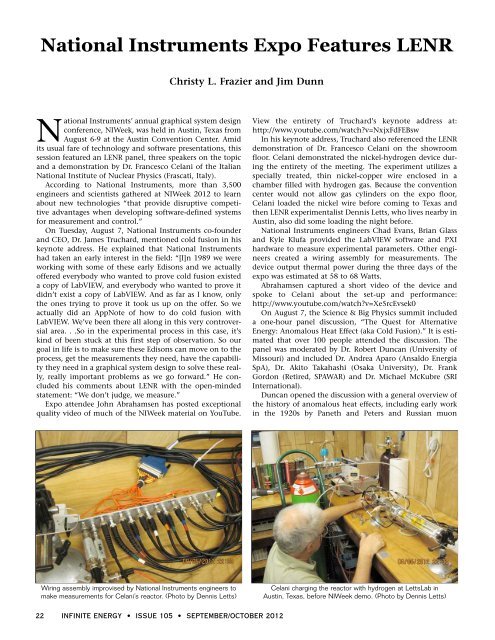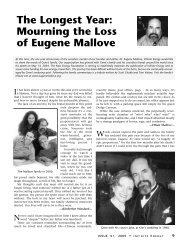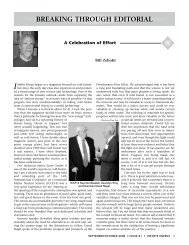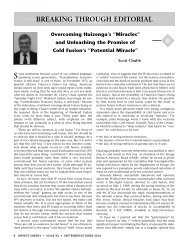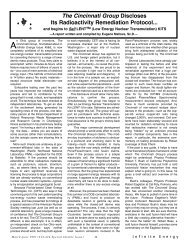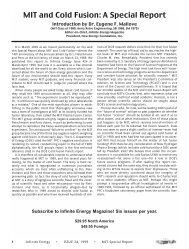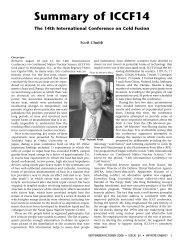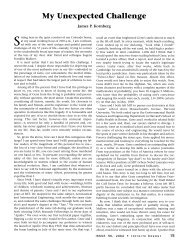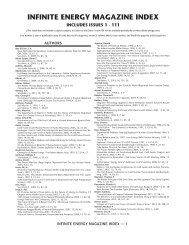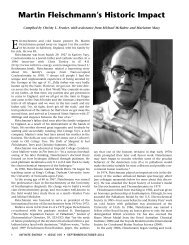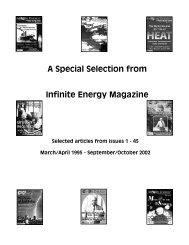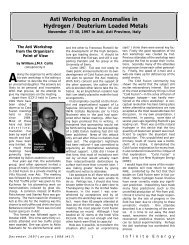National Instruments Expo Features LENR - Infinite Energy Magazine
National Instruments Expo Features LENR - Infinite Energy Magazine
National Instruments Expo Features LENR - Infinite Energy Magazine
Create successful ePaper yourself
Turn your PDF publications into a flip-book with our unique Google optimized e-Paper software.
<strong>National</strong> <strong>Instruments</strong> <strong>Expo</strong> <strong>Features</strong> <strong>LENR</strong><br />
<strong>National</strong> <strong>Instruments</strong>’ annual graphical system design<br />
conference, NIWeek, was held in Austin, Texas from<br />
August 6-9 at the Austin Convention Center. Amid<br />
its usual fare of technology and software presentations, this<br />
session featured an <strong>LENR</strong> panel, three speakers on the topic<br />
and a demonstration by Dr. Francesco Celani of the Italian<br />
<strong>National</strong> Institute of Nuclear Physics (Frascati, Italy).<br />
According to <strong>National</strong> <strong>Instruments</strong>, more than 3,500<br />
engineers and scientists gathered at NIWeek 2012 to learn<br />
about new technologies “that provide disruptive competitive<br />
advantages when developing software-defined systems<br />
for measurement and control.”<br />
On Tuesday, August 7, <strong>National</strong> <strong>Instruments</strong> co-founder<br />
and CEO, Dr. James Truchard, mentioned cold fusion in his<br />
keynote address. He explained that <strong>National</strong> <strong>Instruments</strong><br />
had taken an early interest in the field: “[I]n 1989 we were<br />
working with some of these early Edisons and we actually<br />
offered everybody who wanted to prove cold fusion existed<br />
a copy of LabVIEW, and everybody who wanted to prove it<br />
didn’t exist a copy of LabVIEW. And as far as I know, only<br />
the ones trying to prove it took us up on the offer. So we<br />
actually did an AppNote of how to do cold fusion with<br />
LabVIEW. We’ve been there all along in this very controversial<br />
area. . .So in the experimental process in this case, it’s<br />
kind of been stuck at this first step of observation. So our<br />
goal in life is to make sure these Edisons can move on to the<br />
process, get the measurements they need, have the capability<br />
they need in a graphical system design to solve these really,<br />
really important problems as we go forward.” He concluded<br />
his comments about <strong>LENR</strong> with the open-minded<br />
statement: “We don’t judge, we measure.”<br />
<strong>Expo</strong> attendee John Abrahamsen has posted exceptional<br />
quality video of much of the NIWeek material on YouTube.<br />
Wiring assembly improvised by <strong>National</strong> <strong>Instruments</strong> engineers to<br />
make measurements for Celani’s reactor. (Photo by Dennis Letts)<br />
Christy L. Frazier and Jim Dunn<br />
22 INFINITE ENERGY • ISSUE 105 • SEPTEMBER/OCTOBER 2012<br />
View the entirety of Truchard’s keynote address at:<br />
http://www.youtube.com/watch?v=NxjxFdFEBsw<br />
In his keynote address, Truchard also referenced the <strong>LENR</strong><br />
demonstration of Dr. Francesco Celani on the showroom<br />
floor. Celani demonstrated the nickel-hydrogen device during<br />
the entirety of the meeting. The experiment utilizes a<br />
specially treated, thin nickel-copper wire enclosed in a<br />
chamber filled with hydrogen gas. Because the convention<br />
center would not allow gas cylinders on the expo floor,<br />
Celani loaded the nickel wire before coming to Texas and<br />
then <strong>LENR</strong> experimentalist Dennis Letts, who lives nearby in<br />
Austin, also did some loading the night before.<br />
<strong>National</strong> <strong>Instruments</strong> engineers Chad Evans, Brian Glass<br />
and Kyle Klufa provided the LabVIEW software and PXI<br />
hardware to measure experimental parameters. Other engineers<br />
created a wiring assembly for measurements. The<br />
device output thermal power during the three days of the<br />
expo was estimated at 58 to 68 Watts.<br />
Abrahamsen captured a short video of the device and<br />
spoke to Celani about the set-up and performance:<br />
http://www.youtube.com/watch?v=Xe5rcEvsek0<br />
On August 7, the Science & Big Physics summit included<br />
a one-hour panel discussion, “The Quest for Alternative<br />
<strong>Energy</strong>: Anomalous Heat Effect (aka Cold Fusion).” It is estimated<br />
that over 100 people attended the discussion. The<br />
panel was moderated by Dr. Robert Duncan (University of<br />
Missouri) and included Dr. Andrea Aparo (Ansaldo Energia<br />
SpA), Dr. Akito Takahashi (Osaka University), Dr. Frank<br />
Gordon (Retired, SPAWAR) and Dr. Michael McKubre (SRI<br />
International).<br />
Duncan opened the discussion with a general overview of<br />
the history of anomalous heat effects, including early work<br />
in the 1920s by Paneth and Peters and Russian muon<br />
Celani charging the reactor with hydrogen at LettsLab in<br />
Austin, Texas, before NIWeek demo. (Photo by Dennis Letts)
esearch in the 1950s. Duncan concluded, “When you look<br />
at the level of heat release from these very, very small structures,<br />
it’s much more intense than what you would expect<br />
from the enthalpies of the chemical reaction, often by a factor<br />
of 1,000 or 10,000. . .The excess heat is real and that is<br />
confirmed by many. So this motivates greater scientific<br />
investment. . .This deserves really, really close study. . .”<br />
Each panelist presented a short summary of their work<br />
and interest in <strong>LENR</strong>, to get the audience more familiar with<br />
work being done in the <strong>LENR</strong> field.<br />
McKubre stated that “something about nuclear physics<br />
needs to be fundamentally interrogated and re-evaluated.”<br />
He related an interesting story about being summoned to the<br />
Stanford office of Dr. Edward Teller in the early 1990s to discuss<br />
the <strong>LENR</strong>-related research that McKubre’s team was<br />
doing at SRI. Teller said, “You haven’t convinced me yet. But<br />
if what you say is true, it would take a very small change of<br />
the laws of nuclear physics as I understand them to explain<br />
this effect.” McKubre said that Teller made two suggestions<br />
that he ignored at the time but now has found very useful. In<br />
particular, Teller suggested that they make the experiments “a<br />
function of the ratio of deuterium to hydrogen in the electrolytic<br />
system—change the D to H ratio.” McKubre lamented,<br />
“I didn’t do it. Should have. Had I done it then, we would<br />
have been well in advance of the situation we find ourselves.”<br />
Aparo, Senior Advisor of Research and Development at<br />
Ansaldo (known primarily as Italy’s leading producer of thermoelectric<br />
power plants), mentioned recent European meetings<br />
on emerging energy technologies. EU politicians, he<br />
said, are interested. Aparo indicated that his department presented<br />
a report on various anomalous effects, including<br />
<strong>LENR</strong>. He said, “What we showed them is very simple. Data.<br />
Factual data. That’s more than enough to convince people.”<br />
EU officials have apparently encouraged further work, saying,<br />
“Go where the data leads you. We will not follow you,<br />
we will walk with you towards that direction.”<br />
Takahashi pointed out that “the biggest obstacle to <strong>LENR</strong><br />
research in Japan is funding, which has been reduced dramatically<br />
to almost nothing.”<br />
Gordon explained the importance of using the scientific<br />
process in which they conducted experiments and published<br />
the results in peer-reviewed technical journals. They have<br />
published over 20 papers that document the production of<br />
excess heat, hot spots on the cathode, transmutation to elements<br />
that were not present when the experiment started,<br />
and the production of nuclear products including radiation<br />
and neutrons. While these results address many of the objections<br />
raised by physicists, theory is still lacking. Gordon stated,<br />
“They said it doesn’t match theory. And it still doesn’t<br />
match theory. And, in fact, one of the theories it doesn’t<br />
match is it doesn’t produce as many neutrons as theory predicts<br />
it should, which is fortunate for us because otherwise I<br />
think we’d all be dead.” He suggested that the levels are 6-7<br />
orders of magnitude less than predicted.<br />
When the discussion was opened up to the audience,<br />
numerous questions were asked about theory and experiment.<br />
<strong>National</strong> <strong>Instruments</strong>’ Truchard took the opportunity<br />
to introduce Dr. Peter Hagelstein. In his keynote, he mentioned<br />
that Hagelstein “has worked on some 282 theories<br />
about how it works. His latest one he thinks is his best one.”<br />
Hagelstein briefly discussed a new model he has proposed<br />
based on coupling between vibrations in the lattice and<br />
nuclear excitations.<br />
Celani spoke for a few minutes about the work that led up<br />
to his demonstration. Alex Xanthoulis, CEO of Defkalion<br />
Green Technologies, indicated that they have nearly finished<br />
all the R&D on their Hyperion reactor and are in negotiations<br />
to open branches in numerous countries, including<br />
moving their headquarters to Vancouver, Canada.<br />
Video of the full panel discussion is available at:<br />
http://www.youtube.com/watch?v=iS4qNbMCBL0<br />
On August 8, three individual <strong>LENR</strong> presentations were<br />
given. John Hadjichristos (Defkalion) presented “Hyperion:<br />
Commercialization of <strong>LENR</strong>.” He said that, “Defkalion’s<br />
understanding of the physics involved in <strong>LENR</strong> controlled<br />
phenomena is performed in Hyperion lab prototypes.” They<br />
have found, like others, that “the common environment in<br />
which <strong>LENR</strong> occurs is vacancies on the crystal lattice of a<br />
‘nuclear active environment’ with a heavy metal, such as<br />
nickel, with proper size and geometry where excited atoms<br />
of hydrogen interact, resulting in different transmutation<br />
paths followed by a resonance process that dissipates excess<br />
heat energy.” The propose that commercializing <strong>LENR</strong><br />
“requires a plethora of future needs such as the development<br />
of new materials, new instrumentation and test protocols,<br />
and even the establishment of an international independent<br />
scientific and standards body for this new scientific and<br />
industrial sector.”<br />
Akito Takahashi (Osaka University) presented on the<br />
“Status of CMNS/CF/<strong>LENR</strong> Research at Kobe-Technova.” The<br />
speech covered his team’s work to “elucidate the underlying<br />
physics of anomalous heat evolution effects in deuterium<br />
and protium gas-loaded nano-metal-compound systems.”<br />
He said that they have “reproducibly observed anomalous<br />
heat effects with isotopic differences using time-dependent<br />
(dynamic) data of thermal power evolutions, D(H) metalatom<br />
loading rations and temperature dependence (for Nibased<br />
cases).”<br />
“Commercialization of <strong>LENR</strong> Technology” from the perspective<br />
of Robert Godes (Brillouin <strong>Energy</strong>) included a discussion<br />
of research attempts to understand the intense heat<br />
release of Pd-D or Ni-H reactions. He spoke about ways in<br />
which Brillouin <strong>Energy</strong> has “demonstrated control over the<br />
reaction” and discussed more generally what types of sys-<br />
Dennis Letts, Francesco Celani and Chad Evans, Systems Engineer<br />
for <strong>National</strong> <strong>Instruments</strong>. (Photo courtesy of Dennis Letts)<br />
SEPTEMBER/OCTOBER 2012 • ISSUE 105 • INFINITE ENERGY 23
tems might move to commercialization and the applications<br />
these systems will address.<br />
Video of Hadjichristos’ full talk and part of Takahashi’s is<br />
available at http://www.youtube.com/watch?v=GG5FKjibgAw.<br />
Also on August 8, Duncan joined <strong>National</strong> <strong>Instruments</strong>’<br />
software architect Greg Morrow and Director of Software<br />
Marketing Shelly Gretlein for an informative keynote discussion<br />
on “Anomalous Heat Effects.” (See the video by<br />
clicking on the title of the talk, under the date and names<br />
above: http://www.ni.com/niweek/keynote_videos.htm.)<br />
Gretlein opened by saying that <strong>National</strong> <strong>Instruments</strong>, as<br />
software tool providers, are working towards “empowering<br />
engineers and scientists that are working on these unsolved<br />
problems.” Morrow explained how the company’s interest in<br />
<strong>LENR</strong> has evolved. He said, “Whenever I see Dr. T[ruchard]<br />
talking more often than usual or more excitedly than usual<br />
with my chief scientist Dr. Lothar Wenzel, I know the game<br />
is afoot. In this case, they were getting excited about the<br />
anomalous heat experiments, not just because of the potential<br />
for new science and technology or a novel energy source<br />
but also because such a longstanding mystery seemed like a<br />
great opportunity to apply LabVIEW and accelerate the science.”<br />
Cutting edge science needs advanced instrumentation.<br />
The company has worked closely with <strong>LENR</strong> theorist Prof.<br />
Yeong Kim (Purdue) to develop software that addresses theory.<br />
Morrow said, “Under Dr. Kim’s guidance, we’ve created<br />
a number of different simulations in LabVIEW to explore<br />
more basic aspects of the theory. One of the common<br />
threads in several of the theories is the notion of lattice<br />
vibrations in the solid palladium, so we created this VI [virtual<br />
instrument file] that helps us understand and visualize<br />
the fundamental vibrational modes of a palladium lattice<br />
when it’s been loaded with deuterium.”<br />
And, <strong>National</strong> <strong>Instruments</strong> has also worked with experimentalist<br />
Dennis Letts. Morrow explained, “Our goal was to<br />
optimize certain experimental parameters, and find the optimal<br />
value that gives us the greatest generated heat and to do<br />
so we needed a fast, accurate temperature measurement at<br />
Excess Heat: Why Cold Fusion Research Prevailed<br />
by Charles G. Beaudette<br />
The second edition of Excess Heat<br />
offers a greatly expanded presentation<br />
of the evidence for low level<br />
nuclear reactions as the source of<br />
excess heat, and the discharge of<br />
excess heat without the presence of<br />
an input excitation energy.<br />
$29.95 North America<br />
$39.95 Foreign<br />
(Prices Include Postage)<br />
2002, 440 pp.<br />
New <strong>Energy</strong> Foundation, Inc.<br />
P.O. Box 2816 — Concord, NH 03302-2816<br />
Phone: 603-485-4700 — Website: www.infinite-energy.com<br />
24 INFINITE ENERGY • ISSUE 105 • SEPTEMBER/OCTOBER 2012<br />
Alex Xanthoulis, Frank Gordon, Andrea Aparo, Peter Hagelstein,<br />
James Truchard, Michael McKubre, Robert Godes, Stefano<br />
Concezzi and Robert Duncan. (Photo courtesy of Brillouin <strong>Energy</strong>)<br />
the cathode, which is the site of the generation of the heat.”<br />
They ran into problems with IR imaging the cathode,<br />
because the cathode is submerged in an electrolytic bath<br />
which is opaque to IR radiation. They needed to get creative.<br />
He described an “inverse solver” that deduces the hot spot<br />
measurement below the water line based on what is happening<br />
above the water line.<br />
Duncan touched on the work that will be undertaken by<br />
the Sidney Kimmel Institute for Nuclear Renaissance at the<br />
University of Missouri. He stated, “We are very committed to<br />
expand the experimental range of inquiry, our experimental<br />
approach—expand that following strictly the scientific<br />
method to the point where we’ll be able to get at what the<br />
actual underlying mechanism is.”<br />
The presentation ended with a quote by Duncan that<br />
seems fitting for ending this report: “There’s always risk<br />
whenever you explore the unknown. But what history has<br />
shown us time and time again is that the risk of not taking<br />
a risk is often far greater than the risk itself.”<br />
The Science of Low <strong>Energy</strong> Nuclear Reaction:<br />
A Comprehensive Compilation of Evidence and<br />
Explanations About Cold Fusion<br />
Hardcover, 2007, 312 pages<br />
by Edmund Storms<br />
Catalogues and evaluates the evidence<br />
for cold fusion and shows why the initial<br />
reaction to cold fusion was driven more<br />
by self-interest than fact.<br />
$87.00 North America<br />
$100.00 Foreign<br />
Prices include shipping.<br />
New <strong>Energy</strong> Foundation • P.O. Box 2816 • Concord, NH 03302-2816<br />
Phone: 603-485-4700 • Fax: 603-485-4710 • www.infinite-energy.com


